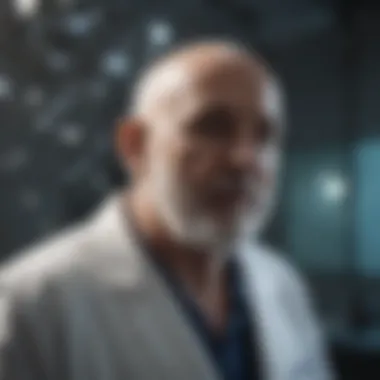Sloan Kettering: Advancements in Brain Cancer Research


Intro
Brain cancer is one of the most challenging areas in oncology. Memorial Sloan Kettering Cancer Center (MSKCC) stands at the forefront of this battle, implementing innovative techniques and therapies aimed at improving patient outcomes. This article aims to thoroughly investigate the advancements in research and treatment methodologies practiced at MSKCC. From advanced surgical protocols to novel chemotherapy regimens, the discussion will provide insights into the complexities and ongoing efforts in this critical field.
Understanding the importance of collaborative care, this exploration will also delve into the significance of clinical trials and the roles a multidisciplinary team plays in orchestrating a patient-centered approach. Each contribution by doctors, nurses, and researchers helps drive innovation forward.
Additionally, the discussion will reflect on future directions in brain cancer treatment and research, highlighting MSKCC's unwavering commitment to enhancing therapeutic efficacy and improving the standards of care. As such, this article serves as an essential resource for students, researchers, educators, and professionals eager to grasp the current landscape in brain cancer care.
Preamble to Sloan Kettering
Sloan Kettering Cancer Center, known for its strategic advancements in cancer research, holds a prominent position in the field of brain cancer treatment. This section explores its historical significance and mission, both critical elements that shape its approach to patient care and innovation in oncology. The institution's long-standing commitment to research and treatment has not only transformed how brain cancer is managed but also improved the quality of life for countless patients.
Historical Overview
The inception of Memorial Sloan Kettering Cancer Center dates back to 1884, making it one of the oldest cancer treatment and research institutions in the world. Over the decades, it has evolved, responding to the changing landscape of cancer treatment and advancing scientific knowledge. The integration of groundbreaking research with clinical practices has characterized its evolution. Key milestones, such as the development of combination chemotherapy and pioneering surgical techniques, reveal its central role in changing treatment paradigms. Understanding this history helps appreciate the depth of expertise that exists today.
Mission and Vision
Sloan Kettering's mission focuses on improving patient outcomes through a triple approach: treatment, research, and education. Its vision is ambitious yet clear—striving for a world where cancer treatment is highly effective and accessible. This mission promotes a synergy of clinical excellence and cutting-edge research, aiming to translate findings from the laboratory directly into patient care. The institution endeavors to maintain its leadership role by fostering innovation. The commitment to a multidisciplinary approach highlights the importance of collaborative care, ensuring that every patient receives comprehensive support tailored to their specific needs.
Understanding Brain Cancer
Understanding brain cancer is crucial for developing effective treatment strategies. This section explores various types of brain tumors, their symptoms, and the diagnostic methods used to identify them. Knowledge in this area has significant implications for patient care, recovery outcomes, and ongoing research initiatives.
Types of Brain Tumors
Primary Brain Tumors
Primary brain tumors originate in the brain itself, making them unique in their presence. These tumors can be benign or malignant and often require specialized treatment. A key characteristic of primary brain tumors is their ability to invade surrounding tissue, leading to various neurological symptoms. This aspect makes them a focal point for research and treatment efforts.
The unique feature of primary brain tumors is their diverse nature, which includes gliomas, meningiomas, and pituitary adenomas. Each type has different characteristics, which influence the approach to treatment. For example, gliomas tend to be aggressive and may require surgery followed by radiation or chemotherapy.
However, the complexity of these tumors presents a challenge, as treatment responses can vary greatly among patients.
Secondary Brain Tumors
Secondary brain tumors, also known as metastatic tumors, arise from cancer that has spread to the brain from other parts of the body. This type is more common than primary tumors and indicates advanced stages of cancer. A key characteristic of secondary tumors is their aggressiveness. They generally require immediate attention and a comprehensive treatment strategy due to their invasive nature.
The advantage of recognizing secondary brain tumors lies in early detection. Identifying the primary cancer can lead to a more effective overall treatment plan. However, the prognosis is often less favorable than primary tumors, complicating treatment decisions.
Rare Brain Tumor Types
Rare brain tumor types include conditions like ependymomas and choroid plexus tumors. Their rareness presents unique challenges and opportunities for research. These tumors often have distinct biological behaviors and treatment responses. One key aspect of rare tumors is their unpredictability in growth patterns.
The benefit of focusing on these rare types can lead to advancements in understanding brain cancer as a whole. However, the limited number of cases can hinder large-scale research, making it vital for institutions like Sloan Kettering to pioneer studies in this area.
Symptoms and Diagnosis
Common Symptoms
Common symptoms of brain cancer often manifest as neurological signs, including headaches, seizures, and cognitive changes. These symptoms emphasize the importance of early detection. A key characteristic is their gradual onset, which can lead to delays in diagnosis. This aspect is vital for discussing patient outcomes, as early treatment generally improves prognosis.
The unique feature of these symptoms is their overlap with various other conditions. This can complicate initial assessments. Thus, awareness and education about these signs are crucial for timely medical intervention.
Diagnostic Imaging
Diagnostic imaging uses technologies like MRI and CT scans to visualize brain tumors. These imaging techniques are critical for accurate diagnosis and treatment planning. A key characteristic of diagnostic imaging is its non-invasive nature, allowing for repeated assessments as needed. This is beneficial for monitoring treatment effectiveness and changes in tumor size.
The unique advantage of modern imaging techniques is their ability to provide detailed images of brain structures and tumors, facilitating precise localization. However, accessibility can vary, impacting timely diagnosis for some patients.


Biopsy Procedures
Biopsy procedures are central to confirmed brain cancer diagnosis. This process involves extracting tissue samples for pathological examination. A key characteristic of biopsies is their ability to provide specific tumor types and grades, significantly influencing treatment decisions. This makes them a vital aspect of patient care.
Unique features of biopsy methods, such as stereotactic biopsy, allow for minimal invasiveness while achieving accurate results. However, the procedure carries risks, including infection and complications, which must be addressed with patients beforehand.
"Understanding the intricate details of brain cancer, from its types to the symptoms and diagnostic techniques, is essential for enhancing treatment efficacy and patient outcomes."
In summary, a deeper understanding of brain cancer is essential for advancing both research and clinical practices. By exploring the various tumor types and diagnostic methods, one may appreciate how this knowledge leads to improved treatment strategies.
Treatment Modalities at Sloan Kettering
The treatment modalities at Sloan Kettering are a vital part of their approach to brain cancer care. They offer a variety of options that cater to the needs of patients. These treatment strategies aim to increase survival rates and improve the quality of life. The blend of advanced techniques—surgery, chemotherapy, radiation, and immunotherapy—illustrates the institution's commitment to individualized patient care. Every modality has its specific benefits and considerations, making them important for comprehensive treatment plans.
Surgical Interventions
Neurosurgical Techniques
Neurosurgical techniques at Sloan Kettering represent a cornerstone of brain cancer treatment. These techniques allow for the precise removal of tumors, enhancing the possibility of total excision while minimizing damage to healthy brain tissue. A key characteristic of these methods is their ability to combine advanced imaging technologies. This integration enables surgeons to visualize tumors in real-time, increasing effectiveness during operations. The unique feature of these techniques is their adaptability, which caters to varying tumor types and patient conditions. While highly beneficial, these methods do come with risks, including infection and potential neurological effects, making careful consideration during planning critical.
Minimally Invasive Surgery
Minimally invasive surgery is another innovative approach used in treating brain tumors at Sloan Kettering. This method decreases recovery time and minimizes scarring due to smaller incisions. A key characteristic is its use of specialized instruments and imaging systems. This makes it a more favorable option for patients, as it is associated with less postoperative pain. The unique feature here involves the surgeon's ability to conduct the operation with precision, reducing trauma to surrounding tissues. Despite its advantages, not all tumors are suitable for this technique, which limits its applicability.
Postoperative Care
Postoperative care at Sloan Kettering plays a crucial role in the treatment process. This phase focuses on monitoring recovery and managing complications. A key characteristic is the personalized approach taken by the care teams, ensuring that each patient receives tailored support. Unique features of postoperative care include symptom management strategies and rehabilitation services, which can greatly enhance recovery. The disadvantage is that complex cases may involve prolonged hospital stays and extensive follow-up, which can be burdensome for patients.
Chemotherapy Approaches
Conventional Chemotherapy
Conventional chemotherapy remains a foundational treatment for brain cancer at Sloan Kettering. This approach utilizes powerful drugs aimed at eliminating cancer cells. A key characteristic is its systemic reach, allowing it to target cancer cells throughout the body. This method is popular for its established efficacy and extensive research backing. The unique feature is the protocol customization based on tumor type and patient response. However, side effects like nausea and fatigue can limit its tolerability.
Targeted Therapy
Targeted therapy represents a more modern advance in treatment approaches. This modality focuses on specific molecular targets related to cancer. A significant characteristic is its ability to minimize damage to healthy cells, offering a more effective treatment option. Patients benefit from less severe side effects compared to conventional chemotherapy. This unique feature, which involves identifying genetic mutations, can enhance treatment efficacy. Still, accessibility to these therapies might be limited, and not all patients may qualify.
Combination Therapies
Combination therapies leverage multiple treatment modalities to enhance effectiveness. This strategy is particularly relevant for aggressive brain tumors. A key characteristic is its capacity to tackle cancer from various angles, improving outcomes. The benefits of combination therapies include increased survival rates and reduced chances of tumor recurrence. Unique features involve personalized treatment regimens tailored to patient needs. However, the complexity of managing potential side effects poses challenges that require careful coordination among healthcare teams.
Radiation Therapy Innovations
Stereotactic Radiosurgery
Stereotactic radiosurgery is a non-invasive treatment option for brain tumors at Sloan Kettering. This innovative approach delivers high doses of radiation precisely to the tumor while sparing normal tissue. A crucial characteristic is its ability to treat tumors that are difficult to access surgically. The unique feature includes its capacity to reduce the need for invasive procedures. Despite its high precision, radiation exposure can lead to complications, including inflammation and damage to surrounding structures.
Fractionated Radiation
Fractionated radiation therapy splits the total dose of radiation into several smaller doses administered over time. This method allows for a better tolerance of the treatment. A key characteristic is its balance in maximizing tumor control while minimizing side effects. It is considered a beneficial strategy for larger tumors or when healthy tissue preservation is crucial. However, the longer treatment schedules can be inconvenient for patients, burdensome in scheduling and transportation.
Adjuvant Radiation Therapy
Adjuvant radiation therapy is often employed following surgery to eliminate remaining cancer cells. This modality enhances the overall success of surgical interventions. A key characteristic lies in its potential to prevent recurrence. Its benefit is significant, particularly for aggressive tumors with high recurrence rates. The uniqueness of this treatment is the timing and sequence in combining with other modalities. Yet, the potential for side effects, such as fatigue and skin irritation, must not be overlooked.
Role of Immunotherapy
Monoclonal Antibodies
Monoclonal antibodies represent a promising avenue in brain cancer treatment at Sloan Kettering. They are designed to target specific antigens on cancer cells. A key feature is their precision, leading to fewer side effects compared to traditional therapies. The unique aspect is the potential for long-term immune memory, which helps prevent cancer recurrence. Nevertheless, not all patients respond, which can limit their effectiveness for some.


Checkpoint Inhibitors
Checkpoint inhibitors are another significant component of immunotherapy. These agents help the immune system recognize and attack cancer cells. A key characteristic is their ability to enhance the body’s natural immune response. They are a beneficial choice, especially for tumors with specific genetic traits. The unique aspect is their capacity to provide durable responses in some patients. However, challenges include immune-related side effects, which need to be managed carefully.
Clinical Trials of Immunotherapy
Clinical trials of immunotherapy at Sloan Kettering offer patients access to innovative treatments. These trials are essential in understanding the effectiveness and safety of new drugs. A key characteristic is their potential to lead to breakthroughs in care. Patients benefit from being at the forefront of research, contributing to advancements. The unique feature of these trials is the collaboration between researchers and clinical teams. However, it is critical to consider the uncertainties involved in experimental treatments.
Research and Clinical Trials
Research and clinical trials are vital components in the advancement of brain cancer treatment at Memorial Sloan Kettering Cancer Center. They ensure that patients benefit from the most effective and innovative therapies available. This process involves rigorous scientific exploration with the aim of finding new ways to diagnose and treat brain tumors. Ongoing studies not only provide critical data on treatment efficacy but also contribute to the body of knowledge that enhances clinical practices.
Importance of Clinical Trials
Clinical trials offer an opportunity for patients to access new therapies that are not yet widely available. They play a significant role in determining the safety and effectiveness of treatments. By participating in clinical trials, patients can contribute to research that may lead to breakthroughs in brain cancer therapies. Additionally, these trials help identify which patient populations benefit the most from certain interventions.
Patients may choose to engage in clinical trials for various reasons. Not all standard treatment options work for everyone. Trials can provide alternates. Furthermore, involvement gives patients a sense of contribution toward scientific progress. This can be empowering for individuals facing uncertain health challenges.
Ongoing Research Initiatives
Genetic Research
Genetic research investigates the role of genes in brain cancer. This aspect examines how specific genetic mutations can influence tumor behavior and response to treatments. An important characteristic of this research is its potential to lead to personalized treatment plans tailored to the patient's unique genetic profile. This tailored approach contributes significantly to optimizing therapeutic outcomes.
One unique feature of genetic research is its ability to provide insights into hereditary cancer risks. Understanding these risks can be crucial for early detection and prevention strategies. However, genetic research can have limitations. For instance, while advancements in technology improve genomic profiling, there may be gaps in data interpretation.
Novel Therapeutics
Novel therapeutics encompass new drugs and treatment modalities that are under investigation. They aim to improve the efficacy of brain cancer treatment compared to traditional options. One of the main characteristics of novel therapeutics is their targeted action against cancer cells, often minimizing damage to healthy tissues. This specificity enhances the potential for better patient outcomes.
A unique feature of this area is its focus on combination strategies. Innovation often lies in pairing different therapies to attack tumors on multiple fronts. However, challenges exist. For example, the complexity of tumor biology can make it difficult to predict responses to novel combinations.
Patient-Contributed Data Studies
Patient-contributed data studies gather information directly from patients regarding their experiences with treatment. This approach enriches research by including real-world evidence. One of the key characteristics of these studies is their emphasis on patient-reported outcomes. This helps ensure that future treatment protocols align more closely with patient needs and preferences.
The unique feature of these studies is that they empower patients, allowing them to take part in the research process actively. However, balancing privacy concerns with data collection remains a delicate consideration. The integration of robust data protection measures is essential while conducting these investigations.
"The advancement of brain cancer research relies on the dual pillars of clinical trials and innovative research initiatives, allowing for a deeper understanding of treatment efficacy and patient needs."
In summary, the emphasis on research and clinical trials at Memorial Sloan Kettering Cancer Center is a cornerstone of their approach to brain cancer treatment. These efforts are designed to ensure that patients not only receive cutting-edge therapies but also contribute to the collective understanding of the disease, leading to better outcomes for future patients.
Multidisciplinary Approach to Care
A multidisciplinary approach plays a crucial role in the treatment of brain cancer at Sloan Kettering. This method integrates various specialties, enabling a comprehensive care plan tailored to each patient. Such collaboration ensures that different perspectives and expertise come together, fostering improved decision-making in treatment strategies. Patients benefit from diverse inputs, leading to higher quality care, better management of symptoms, and enhanced overall outcomes.
Team Composition
Neurosurgeons
Neurosurgeons are pivotal in the diagnosis and treatment of brain tumors. Their expertise lies in surgical techniques that address a range of conditions. The key characteristic of neurosurgeons is their ability to perform intricate brain surgeries with precision. This specialty is beneficial because it directly impacts tumor removal and can potentially lead to longer survival rates. The unique feature of neurosurgeons at Sloan Kettering is their use of advanced surgical technologies. These techniques may minimize damage to surrounding tissues, although they require substantial expertise and experience in elegant surgical maneuvers.
Medical Oncologists
Medical oncologists are essential for managing the systemic treatment of brain cancer. They focus on chemotherapy and systemic therapies that target cancer cells throughout the body. Their key characteristic includes a deep understanding of drug interactions and specific cancer types. This is beneficial in crafting personalized treatment plans. One unique aspect of medical oncologists at Sloan Kettering is their involvement in clinical trials that investigate new therapeutic options. However, chemotherapy may have side effects, which require effective management to ensure quality of life.
Radiation Oncologists
Radiation oncologists contribute significantly to brain cancer management through the application of radiation therapy. Their expertise is in devising radiation treatment plans tailored to tumor type and location. The critical characteristic of radiation oncologists is their understanding of dosimetry, which is crucial for maximizing treatment benefits while minimizing damage to healthy tissue. This approach is beneficial as it can lead to improved tumor control rates. A unique feature of radiation oncologists at Sloan Kettering is their ongoing research to enhance radiation techniques, though these treatments can bring about fatigue and other side effects.
Nurses and Support Staff


Nurses and support staff are vital in providing holistic care. They ensure that patients receive the necessary support during their treatment journey. The key characteristic of nurses includes their extensive training in patient care and management. This is beneficial as they provide not only clinical care but also emotional support to patients and families. A unique aspect of the nursing team at Sloan Kettering is their focus on continuity of care, which fosters trust and comfort for patients. However, the emotional toll of watching patients struggle can impact the well-being of support staff.
Integrative Oncology Services
Psychological Support
Psychological support is a crucial component of comprehensive cancer care. It addresses the emotional and mental health challenges that arise during treatment. The key characteristic of psychological support services is their focus on individual patient needs. This is beneficial in helping patients cope with the stress of diagnosis and treatment. At Sloan Kettering, the unique feature of these services includes personalized counseling and support groups, though it might require openness and willingness from the patient to engage effectively.
Nutritional Counseling
Nutritional counseling plays an important role in supporting patients throughout their treatment. It focuses on the diet's impact on overall health and recovery. The key characteristic is the tailored dietary plans that cater to individual needs. This is beneficial, particularly for addressing treatment side effects and bolstering the immune system. A unique feature of nutritional counseling at Sloan Kettering is the collaboration with oncology dietitians, ensuring optimal nutritional intake, though some patients may find dietary changes challenging to implement.
Rehabilitation Services
Rehabilitation services are essential for patients recovering from brain cancer treatments. They focus on physical, cognitive, and emotional recovery, adapting the care to the patient's needs. The key characteristic of rehabilitation services is their holistic approach, addressing various facets of recovery. This is beneficial in improving the quality of life post-treatment. A unique aspect of these services at Sloan Kettering is their focus on individualized programs, although this can require time and commitment from the patient.
A multidisciplinary approach to care is essential for achieving optimal outcomes in brain cancer treatment.
Patient Outcomes and Quality of Life
The concept of patient outcomes and quality of life is essential in the realm of brain cancer treatment. At Memorial Sloan Kettering Cancer Center, the focus extends beyond merely addressing the illness; it encompasses enhancing the overall well-being of patients. The integration of clinical efficacy with supportive care is fundamental in improving both short-term and long-term outcomes for individuals facing brain tumors.
Long-term prognosis plays a significant role in shaping treatment plans and ensuring that patients have a clear understanding of their health journey. These prognosis assessments not only evaluate survival rates but also consider the potential impact on cognitive functions, emotional health, and daily living post-treatment. Given the complexities associated with brain cancer, factors such as tumor type, location, and treatment response must be analyzed carefully. Understanding these insights helps clinicians to provide tailored advice and highlights the importance of ongoing monitoring after initial treatments.
- Advances in surgical techniques can lead to better removal of tumors, which is often associated with improved prognosis.
- New chemotherapy methods aim to target specific cancer cells while preserving healthy brain tissue.
- Immunotherapy has emerged as a promising avenue, showing potential to extend life expectancy while enhancing quality of life.
Equally important are the survivorship programs in place for patients at Sloan Kettering. These programs provide necessary support and resources to those who have completed their treatment. Survivorship programs emphasize not only medical follow-ups but also holistic approaches to recovery.
Incorporated within these programs are various elements that strengthen the overall quality of life for survivors, including:
- Support Groups: Connecting with fellow survivors provides emotional validation and collective experiences.
- Wellness Programs: These often involve physical therapy, nutritional guidance, and mental health services.
- Educational Workshops: Informing patients about self-care strategies and ways to manage potential long-term side effects.
By prioritizing patient outcomes and quality of life, Sloan Kettering ensures that individuals not only survive but thrive after brain cancer treatment. Continuous follow-up care and tailored survivorship plans can significantly mitigate the psychological and physical challenges faced by patients.
"Survivorship is not just about surviving cancer; it’s about living a fulfilled life post-treatment."
In summary, the commitment of Sloan Kettering to enhance patient outcomes is multi-faceted. Long-term prognosis assessments inform treatment directions, while survivorship programs empower patients to regain control over their lives post-diagnosis. The holistic approach leads to comprehensive cancer care that addresses not only the disease but also the individual as a whole.
Future Directions in Brain Cancer Treatment
The field of brain cancer treatment has made significant advancements, yet there is still much to explore. Understanding future directions in brain cancer treatment is crucial for patients, researchers, and healthcare professionals. The evolving nature of research offers new hope and strategies for addressing the challenges associated with this complex disease. Emerging therapies and personalized medicine promise to refine treatment approaches, enabling more effective management of brain tumors.
Emerging Therapies
Emerging therapies represent a promising frontier in the fight against brain cancer. These therapies often utilize novel mechanisms of action that differ from traditional oncological approaches. For example, targeted therapies are designed to focus on specific genetic mutations found in tumor cells. Such precision can yield better outcomes compared to conventional methods that affect both healthy and cancerous cells.
Additionally, there is growing interest in integrating nanotechnology into brain cancer therapies. Utilizing nanoparticles can enable drugs to more effectively cross the blood-brain barrier, enhancing their availability at the tumor site while minimizing systemic side effects. This area of research holds great potential to improve patient quality of life.
Personalized Medicine
Personalized medicine is reshaping the landscape of brain cancer treatment. It emphasizes tailoring treatment strategies to the individual characteristics of each patient's tumor. Two critical components of personalized medicine are genomic profiling and tailored treatment plans.
Genomic Profiling
Genomic profiling involves analyzing the genetic makeup of a patient's tumor to identify unique mutations and alterations. This information helps in selecting the most effective therapies.
The key characteristic of genomic profiling is its ability to provide insights that are not visible through standard imaging techniques. It is a beneficial choice for developing treatment plans that match the specific tumor biology. One unique feature of genomic profiling is its potential to uncover rare mutations, which may open doors to new treatment options, such as targeted therapies.
One advantage of genomic profiling is that it allows doctors to move away from a one-size-fits-all treatment model. However, the complexity of genetic data requires expert interpretation, which can be a drawback in some cases.
Tailored Treatment Plans
Tailored treatment plans consider individual tumor characteristics, including genetic composition, tumor type, and patient-specific factors like age and overall health. By customizing treatment approaches, healthcare providers can maximize effectiveness while reducing unnecessary side effects.
A key characteristic of tailored treatment plans is their focus on optimizing the therapeutic regimen. This approach is popular in brain cancer management, as it allows for adjustments based on real-time patient and tumor responses.
The unique feature of tailored treatment plans is their adaptability. As new data emerges from genomic profiling, plans can be modified to incorporate the most effective therapies available. However, challenges include potential delays in treatment while adaptations are being made.



